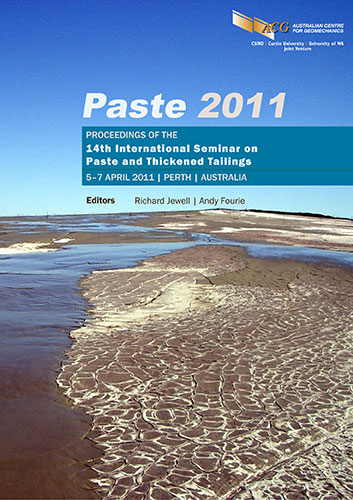Rheology for thickened tailings and paste — history, state-of-the-art and future directions

|
Authors: Sofrà, F; Boger, DV |
DOI https://doi.org/10.36487/ACG_rep/1104_12_Sofra
Cite As:
Sofrà, F & Boger, DV 2011, 'Rheology for thickened tailings and paste — history, state-of-the-art and future directions', in R Jewell & AB Fourie (eds), Paste 2011: Proceedings of the 14th International Seminar on Paste and Thickened Tailings, Australian Centre for Geomechanics, Perth, pp. 131-133, https://doi.org/10.36487/ACG_rep/1104_12_Sofra
Abstract:
A significant development during the evolution of thickened tailings and paste technology has been the increased understanding of the importance of rheology for both design and operation of thickened tailings and paste systems. It is now well accepted that dewatering, pipeline transport and deposition processes are all rheology governed and that the more the rheology is understood, and in some cases manipulated, the more successful the operation will be. This increased knowledge and adoption of rheology has led to a paradigm shift where tailings are engineered to suit the environment rather than engineering the environment to suit the tailings. In the early to mid 1970s when Eli Robinsky first introduced the concept of thickened tailings disposal, the systems were based primarily on empirical flume tests. Since that time, numerous advances in measurement techniques have facilitated the understanding of the influence of variables such as particle size distribution and shape, shear effects (rate and time of shear) and mineralogy on the rheology of tailings. Compressional rheology has also emerged as a whole new area of interest. This progress, coupled with advances in understanding the interrelationship between surface chemistry and rheology, has highlighted methods of exploiting and/or manipulating the dewatering, flow and depositional properties of tailings and backfill. As flocculant and other additive technologies advance, we may begin to see more complex rheological phenomena and new measurement techniques may need to be adopted or developed for a fuller understanding and exploitation of slurry and paste rheology. The paper examines the driving issues faced in the past, now and likely in the future, the testwork that has been developed and its applicability or limitations and how this has progressed thickened tailings and paste technology.
References:
Barnes, H.A. and Carnali, J.O. (1990) The vane-in-cup as a novel rheometer geometry for shear thinning and thixotropic materials, Journal of Rheology, Vol. 34(6), p. 841.
Callaghan, I.C. and Ottewill, J. (1974) Journal of the Chemistry Society Faraday Discussions, Vol. 57, p. 110.
De Kretser, R., Scales, P.J. and Boger, D.V. (1997) Improving clay-Based Tailings Disposal: Case Study on Coal Tailings, AIChE Journal, Vol. 43(7), pp. 1894 –1903.
Fisher, D.T., Scales, P.J. and Boger, D.V. (2007) The bucket rheometer for the viscosity characterization of yield stress suspensions, Journal of Rheology, Vol. 51(5), p. 82.
Kreiger, I.M. and Maron, S.H. (1954) Direct determination of the flow curves of non-Newtonian fluids, III Standardised treatment of viscometric data, Journal of Applied Physics, Vol. 25(1), pp. 72–75.
McFarlane, A., Bremmell, K. and Addai-Mensai, J. (2006) Improved dewatering behaviour of clay mineral dispersions via interfacial chemistry and particle interactions optimization, Journal of Colloid and Interface Science, Vol. 293, pp. 116–127.
Nguyen, Q.D. and Boger, D.V. (1983) Yield stress measurement for concentrated suspensions, Journal of Rheology, Vol. 27, p. 321.
Nguyen, Q.D. and Boger, D.V. (1985) Direct yield stress measurement with the vane method, Journal of Rheology, Vol. 29, p. 335.
Pashias, N. and Boger, D.V. (1996) A fifty-cent rheometer for yield stress measurement, Journal of Rheology, Vol. 40(6), p. 1179.
Robinsky, E.I. (1975) Thickened Discharge – A New Approach to Tailings Disposal, Canadian Mining and Metallurgical Bulletin, Vol. 68, December 1975, pp. 47–53.
Sofra, F. (2001) Minimisation of bauxite tailings using dry disposal techniques, PhD thesis, The University of Melbourne.
Sofra, F. (2005) The importance of understanding feed rheology in nickel laterite processing, in Proceedings Processing Nickel Ores and Concentrates 05, 16–17 November 2005, Cape Town South Africa, MEI, CD-rom only.
Sofra, F., Scales, P.J. and Kilcullen, A. (2007a) Dewatering and clays – the importance of controlling dispersion ‘up-front’, in Proceedings Tenth International Seminar on Paste and Thickened Tailings (Paste07), A.B. Fourie and R.J. Jewell (eds), 13–15 March 2007, Perth, Australia, Australian Centre for Geomechanics, Perth, pp. 229–238.
Sofra, F., Fisher, D.T. and Boger, D.V. (2007b) The bucket rheometer for thickened tailings and paste flow curve determination, in Proceedings Tenth International Seminar on Paste and Thickened Tailings (Paste07), A.B. Fourie and R.J. Jewell (eds), 13–15 March 2007, Perth, Australia, Australian Centre for Geomechanics, Perth, pp. 249–258.
Van Olphen, H. (1977) Introduction to Clay Colloid Chemistry 2nd ed., Wiley, New York.
© Copyright 2025, Australian Centre for Geomechanics (ACG), The University of Western Australia. All rights reserved.
View copyright/legal information
Please direct any queries or error reports to repository-acg@uwa.edu.au
View copyright/legal information
Please direct any queries or error reports to repository-acg@uwa.edu.au